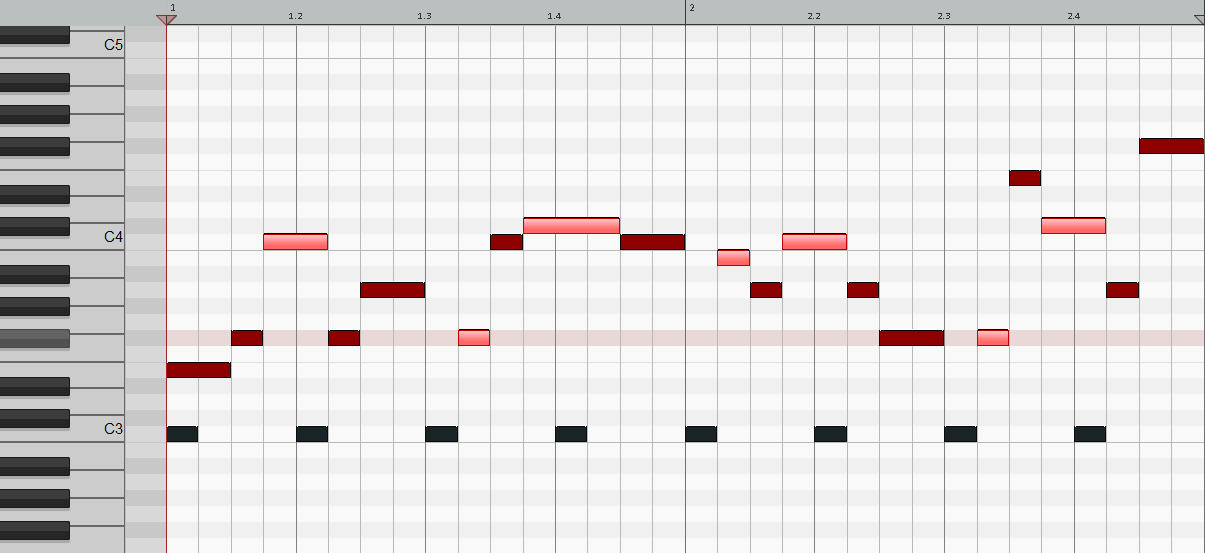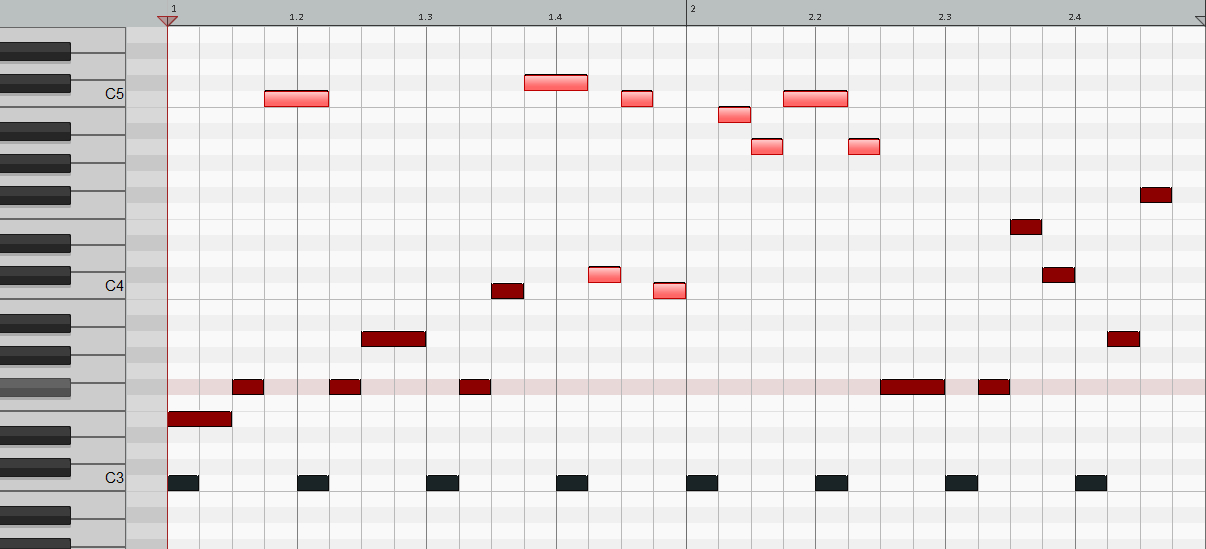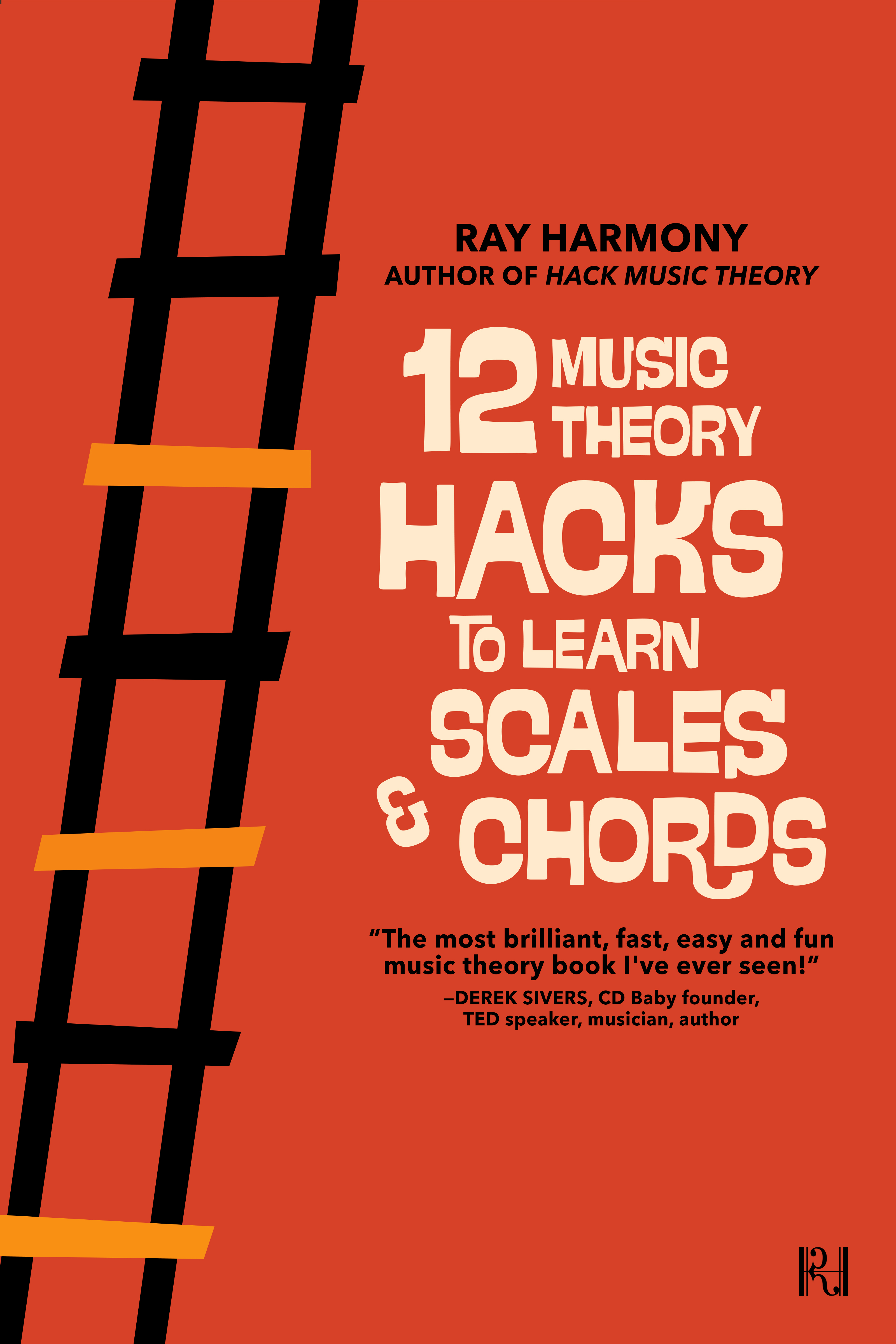Michael from Germany asked us the following question on YouTube: “As I build more interesting bass lines for my EDM track, I run into the problem that some bass notes run parallel with the kick. Sure I can just duck them with a compressor or LFOtool, but I have a feeling that’s not the best option. Or, am I just producing in a genre that has boring bass lines?” Thank you Michael, and no, no genre deserves boring bass lines! This is actually a common problem in EDM that gets very little attention, so we’re excited to shed some light on it, starting with our one-sentence answer:
Using a combination of syncopation, phrasing, and octaves, you can write melodically and rhythmically captivating EDM bass lines, which do not interfere with the kick drum.
Before we get into our MIDI example, let’s first define those terms. Syncopation is accenting an off-beat, phrasing is where the music breathes, and an octave is the same note just a higher or lower pitched version. Also, please note that the problem of bass notes and kick drums being played together is only a problem in some EDM subgenres. This is due to their massive synthesized bass and kick sounds, which need their own individual space in the mix. Most other genres, especially the ones that use live instruments, approach bass and drums in an opposite way. The bassist and drummer are referred to as the rhythm section, and the ultimate rhythm section plays so tightly together that they become one, with many bass notes landing on kicks.
The godfather of groove, James Brown, knew the importance of “the one”, i.e. the first beat of a bar. He demanded that every bar has a bass note and kick played together on the one. The rhythm section could do whatever they wanted for the rest of each bar, but on the one, they had to lock in. This balance between locking in on the one and then using syncopation for the rest of the bar, is what gives funk its groove. So, if James Brown was an EDM producer, he would definitely play the kick and bass together on the one. And, as it’s impossible to argue with James Brown’s superior ability to make people dance, we should probably borrow his technique for Electronic Dance Music, too. This means you’ll need to use LFOtool on the one, so you can play both the bass and the kick together, but then you can put your LFOtool away for the rest of the bar.
For our MIDI example, we’ve just used the most common drum pattern, the four on the floor. However, the following bass hacks will work for any drum pattern you have. Also, we wrote the funky bass line of this example in the F♯ Blues scale, so the notes of our scale are: F♯, A, B, C, C♯, E. And the scale spelling is: 1 ♭3 4 ♭5 5 ♭7. To learn our hacks for writing bass lines in the Blues scale, please download our Hack Music Theory for Songwriting & Producing PDF. Here’s our starting bass line:
 Figure 1: Our original EDM bass line (in F♯ Blues scale), which is currently interfering with the kick drum
Figure 1: Our original EDM bass line (in F♯ Blues scale), which is currently interfering with the kick drum
Now let’s get started. Copy and paste your kick pattern into your bass track, then mute those kick notes. This will show you what beats you need to avoid in your bass line. There are three bass hacks you can use to avoid kicks, and they often work best when used together, so don’t be shy.
 Figure 2: Kick drum pattern copied into bass track and muted (dark notes on C3 in above MIDI)
Figure 2: Kick drum pattern copied into bass track and muted (dark notes on C3 in above MIDI)
Hack 1: Syncopation
Move the beginnings of all your bass notes that are currently landing on kicks. You can start these notes earlier or later, whichever sounds best for each bass note. If you start a note earlier, though, you’ll obviously need to shorten the note before it. This creates a syncopated rhythm, which adds unpredictable excitement to your groove. Here’s what we did:
 Figure 3: Notes that have been shortened and lengthened to avoid kicks (highlighted in above MIDI)
Figure 3: Notes that have been shortened and lengthened to avoid kicks (highlighted in above MIDI)
Hack 2: Phrasing
For all your bass notes that start before a kick drum but then continue sounding over it, you can shorten them to stop on the kick instead. You can also do this anywhere else you feel a musical breath would enliven your bass line. This hack creates phrases, which inject life into your bass line, as the melody is now breathing.
 Figure 4: Notes that have been shortened to create phrasing (highlighted in above MIDI)
Figure 4: Notes that have been shortened to create phrasing (highlighted in above MIDI)
Hack 3: Octaves
Lastly, there will almost certainly be some notes that you don’t want to shorten in order to avoid kicks. For these notes, move them an octave or two higher, so they’re out of the frequency range of the kick. Feel free to move any other notes an octave higher too, to even out the amount of low and high notes, resulting in a more balanced bass line. Also, if any of these high notes are long, you can split them and move the extra one an octave down. This last hack creates a huge range to your bass line, which thrills your listeners with its wildness. And with that, we’re done. James Brown is happy, and we’ve got a kick-ass EDM bass line that does not interfere with the kick!
 Figure 5: Notes that have been moved an octave higher* to avoid kick frequency (highlighted in above MIDI)
Figure 5: Notes that have been moved an octave higher* to avoid kick frequency (highlighted in above MIDI)
*The highlighted C♯ and C that are an octave lower, were cut and moved back down from the high C♯ and C
So that’s our answer! Thanks for watching, and if you’d like more EDM music theory hacks like this, please download our Hack Music Theory for Songwriting & Producing PDF. Do you feel a little bit smarter now than you did a few minutes ago? Then “like” and subscribe so we can do it all again next week! And if you have a question you’d like us to answer here on Hack Music Theory Q&A, then please join our community at Patreon.com/RevolutionHarmony
Kate Harmony
Music Teacher
Victoria BC, Canada
Using a combination of syncopation, phrasing, and octaves, you can write melodically and rhythmically captivating EDM bass lines, which do not interfere with the kick drum.
Before we get into our MIDI example, let’s first define those terms. Syncopation is accenting an off-beat, phrasing is where the music breathes, and an octave is the same note just a higher or lower pitched version. Also, please note that the problem of bass notes and kick drums being played together is only a problem in some EDM subgenres. This is due to their massive synthesized bass and kick sounds, which need their own individual space in the mix. Most other genres, especially the ones that use live instruments, approach bass and drums in an opposite way. The bassist and drummer are referred to as the rhythm section, and the ultimate rhythm section plays so tightly together that they become one, with many bass notes landing on kicks.
The godfather of groove, James Brown, knew the importance of “the one”, i.e. the first beat of a bar. He demanded that every bar has a bass note and kick played together on the one. The rhythm section could do whatever they wanted for the rest of each bar, but on the one, they had to lock in. This balance between locking in on the one and then using syncopation for the rest of the bar, is what gives funk its groove. So, if James Brown was an EDM producer, he would definitely play the kick and bass together on the one. And, as it’s impossible to argue with James Brown’s superior ability to make people dance, we should probably borrow his technique for Electronic Dance Music, too. This means you’ll need to use LFOtool on the one, so you can play both the bass and the kick together, but then you can put your LFOtool away for the rest of the bar.
For our MIDI example, we’ve just used the most common drum pattern, the four on the floor. However, the following bass hacks will work for any drum pattern you have. Also, we wrote the funky bass line of this example in the F♯ Blues scale, so the notes of our scale are: F♯, A, B, C, C♯, E. And the scale spelling is: 1 ♭3 4 ♭5 5 ♭7. To learn our hacks for writing bass lines in the Blues scale, please download our Hack Music Theory for Songwriting & Producing PDF. Here’s our starting bass line:
 Figure 1: Our original EDM bass line (in F♯ Blues scale), which is currently interfering with the kick drum
Figure 1: Our original EDM bass line (in F♯ Blues scale), which is currently interfering with the kick drumNow let’s get started. Copy and paste your kick pattern into your bass track, then mute those kick notes. This will show you what beats you need to avoid in your bass line. There are three bass hacks you can use to avoid kicks, and they often work best when used together, so don’t be shy.
 Figure 2: Kick drum pattern copied into bass track and muted (dark notes on C3 in above MIDI)
Figure 2: Kick drum pattern copied into bass track and muted (dark notes on C3 in above MIDI)Hack 1: Syncopation
Move the beginnings of all your bass notes that are currently landing on kicks. You can start these notes earlier or later, whichever sounds best for each bass note. If you start a note earlier, though, you’ll obviously need to shorten the note before it. This creates a syncopated rhythm, which adds unpredictable excitement to your groove. Here’s what we did:
 Figure 3: Notes that have been shortened and lengthened to avoid kicks (highlighted in above MIDI)
Figure 3: Notes that have been shortened and lengthened to avoid kicks (highlighted in above MIDI)Hack 2: Phrasing
For all your bass notes that start before a kick drum but then continue sounding over it, you can shorten them to stop on the kick instead. You can also do this anywhere else you feel a musical breath would enliven your bass line. This hack creates phrases, which inject life into your bass line, as the melody is now breathing.
 Figure 4: Notes that have been shortened to create phrasing (highlighted in above MIDI)
Figure 4: Notes that have been shortened to create phrasing (highlighted in above MIDI)Hack 3: Octaves
Lastly, there will almost certainly be some notes that you don’t want to shorten in order to avoid kicks. For these notes, move them an octave or two higher, so they’re out of the frequency range of the kick. Feel free to move any other notes an octave higher too, to even out the amount of low and high notes, resulting in a more balanced bass line. Also, if any of these high notes are long, you can split them and move the extra one an octave down. This last hack creates a huge range to your bass line, which thrills your listeners with its wildness. And with that, we’re done. James Brown is happy, and we’ve got a kick-ass EDM bass line that does not interfere with the kick!
 Figure 5: Notes that have been moved an octave higher* to avoid kick frequency (highlighted in above MIDI)
Figure 5: Notes that have been moved an octave higher* to avoid kick frequency (highlighted in above MIDI)*The highlighted C♯ and C that are an octave lower, were cut and moved back down from the high C♯ and C
So that’s our answer! Thanks for watching, and if you’d like more EDM music theory hacks like this, please download our Hack Music Theory for Songwriting & Producing PDF. Do you feel a little bit smarter now than you did a few minutes ago? Then “like” and subscribe so we can do it all again next week! And if you have a question you’d like us to answer here on Hack Music Theory Q&A, then please join our community at Patreon.com/RevolutionHarmony
Kate Harmony
Music Teacher
Victoria BC, Canada
 | |
Wooohooo!!! You're a mere 30 minutes away from being even smarter than you already are. Just head over to your inbox now for your free download.
